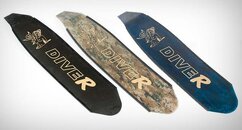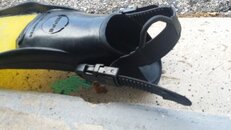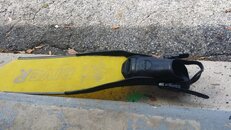- Messages
- 5,884
- Reaction score
- 3,000
- Location
- Lake Worth, Florida, United States
- # of dives
- I'm a Fish!
God, I hated those things!!!
Probably total number of dives with one for me was less than 5....they destroyed my underwater Zen
Welcome to ScubaBoard, the world's largest scuba diving community. Registration is not required to read the forums, but we encourage you to join. Joining has its benefits and enables you to participate in the discussions.
Benefits of registering include
God, I hated those things!!!
Cave Adventurers in Mariana, FL offers a replacement for crotch straps that splits below the scooter ring and goes to either side of the BCD in the back. It solves an obvious comfort issue for those being pulled by a scooter attached to the crotch strap D-ring.
link? Looked, and don't see it....
The first surface floatation device (horse collar) wasn't actually a BC because it was only intended to be used in an emergency at the surface to float a diver face up by pulling a string/lever that released CO2. This was something that was adopted from the military (Navy).Why aren't they? My understanding is that this was the original purpose of the first BCs. To help divers establish buoyancy on the surface. The early BC were modified aviation life preservers (Mae Wests) so they would float an unconscious individual face-up. The horse collar BC's were an evolution of this design. A jacket BC also floats a diver face up only back mounted BCs don't. As Dan points out a skilled diver doesn't need a BC under water, however a tired diver on the surface with negative tanks does.
I realize that manufacturers do not want to say BCs are life preservers because then they would need to meet Coast Guard regulations which they probably couldn't do. It would also open them up to additional liability.
I am not trying to argue with you and I know you are not the first to say this. However, I don't think this was always the case.
Dan......slight digression, but to what fins are you referring? Which ones are you diving? Thanks.I can think of two more cases where the diver drowned at surface, because they panicked and could not remember how to remove their integrated weight...
The big issue is panic though....there are some people that panic easily, with most others in a wide range....
The ones that panic easily, and badly, really can't be divers....I have seen people like this actually forget even how to swim, as the panic overtakes them--even dog paddling is too much--they just thrash.
Which is to say....if just mild panic, the thought is reduced but still possible....the weight belt is still simple and most buddies will know how to remove a weight belt from a buddy....where as you CAN NOT say that most buddies know how to get their buddy out of his/her integrated weights....some just don't make sense...add some fear and panic in the buddy scenario, and both can drown....
Personally I have NEVER used integrated weights...just don't like the idea of them. I had no interest when Carmichael created integrated weight pockets for Halcyon....I saw it as fluff for some dealers, but NOT as something we would ever push as a DIR "optimization"
On the other hand, my wife Sandra uses them sometimes, so obviously I am not trying to push my ideas on anyone....just offering
Then again, I use fins that create so much thrust, that I can carry a good sized anchor, when freediving ---with no BC, so any worry or panic is not feasible with the tiny amounts of weight involved with another diver or myself on scuba....
Which of course, brings me to why good fins and propulsive technique, is almost equally as important as is the choice of BC and Weights
Sadly, fins and propulsive techniques get very little instructional time.
Why aren't they? My understanding is that this was the original purpose of the first BCs. To help divers establish buoyancy on the surface. The early BC were modified aviation life preservers (Mae Wests) so they would float an unconscious individual face-up. The horse collar BC's were an evolution of this design. A jacket BC also floats a diver face up only back mounted BCs don't. As Dan points out a skilled diver doesn't need a BC under water, however a tired diver on the surface with negative tanks does.
Dive-R Freediving & Spearfishing Fins - Hybrid Composite DesignDan......slight digression, but to what fins are you referring? Which ones are you diving? Thanks.



I didn't either. When I was there, we talked about alterations to my Hollis SMS 75, and that was suggested. I said OK and they put it on. Give them a call.
If nothing else, Dan knows his fins!
